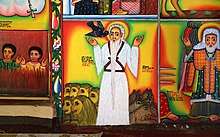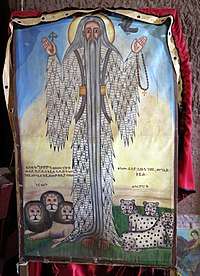Gabra Manfas Qeddus
Gebre Menfes Kidus (Ge'ez: ገብረ መንፈስ ቅዱስ; also familiarly called Abo) was an Egyptian Christian saint, and the founder of the monastery of Zuqualla. The fifth day of every month in the Ethiopian calendar is dedicated to this saint.[1]

Manuscripts differ in relating the story of the life of Gebre Menfes Kidus and the miracles he performed. Unless otherwise stated, the account below is pieced together from various legends about his life.[2]
Life in Egypt
One text reports Gebre Menfes Kidus lived 562 years, 300 of them in Egypt, while another attributes him a life of 362 years.[3] He was born in Nehisa, Egypt to noble parents, named Simon and Eklesia. Eklesia, according to legend, came from the tribe of Benjamin of ancient Israel. Eklesia and Simon are said to have been barren for 30 years. The day of Gebre's conception and the date of his birth are said to coincide with those of Jesus Christ.
Forty days after his birth, the baptism of Gebre Menfes Kidus was celebrated with a banquet attended by the Roman emperor. He developed traits common to all prodigious children. By the age of two, tradition reports that he was already wise. When he was three years old, God sent his archangel Gabriel to the child, to take him into the desert and put him into the custody of the monk Zamada Berhan, leaving his parents and nurse in despair. There he was ordained priest and became an abbot.

For a time Gebre remained in the desert performing miracles, while people from remote countries visited him. Then a second time God sent Gabriel to take Gebre deeper into the desert, and to have him live amongst 60 lions and 60 leopards. While there, Gebre Menfes Kidus developed thick white hair covering all his body like a coat. He was able to appease the wild beasts, and in this respect resembled the figure of Daniel from the Old Testaments, as he was able to talk to the animals.
In Ethiopian iconography, Qeddus is commonly depicted in full view standing upright, covered by his hair from top to toe, while lions and leopards rest at his feet.[4]
Journeys to the Holy Land
Gebre Menfes Kidus set out for a journey into the Holy Land. He visited all the holy places, including Bethlehem, Jerusalem, Nazareth and the river Jordan. God incited him to go to Gabaon, where the devil assaulted him with wild beasts. Attacked by a serpent, Gebre won the battle, and the serpent was petrified by him. Gebre Menfes Kidus begged the Lord to make him invisible, so as to prevent humans and supernatural beings alike from recognizing him and putting him to the test.
Life in Ethiopia
When Gebre Menfes Kidus was 300 years of age, the Lord ordered him to go to Ethiopia to preach to the people there. He travelled there on a winged chariot, accompanied by his leopards and lions. In Ethiopia he founded the monastery of Zuqualla, an extinct volcano, which is in the southern part of the former province of Shewa (now in Ada'a Chukala woreda). Zuqualla is an icon for Mount Tabor in the Holy Land.
Some texts say that, before establishing his monastery, Gebre Menfes Kidus was tempted by demons and devils for a period of hundred years, after which time the Lord exempted the Ethiopians from sin. Gebre left Zuqualla to wander to Kabd in order to stare at the heavens for seven months without blinking. The devil, in the shape of a raven, came to pick out his eyes. But Menfes Kidus was cured by the archangels Gabriel and Michael, who brought him back to Zuqualla.
Some manuscripts recount a visit to heaven, where Gabra Manfas Qeddus was kissed by the Holy Trinity. While he was still on his way back from heaven, three other saints arrived in Kabd to visit him -- Samuel of Waldebba, Anbas of Hazalo, and Benyam of lower Begemder—who were all accompanied by lions. As soon as the lions and leopards of Gebre Menfes Kidus noticed their fellow creatures, though, they devoured them. Nothing was left of them when Menfes Kidus eventually arrived on the scene. When Gebre ordered his animals to spit out the remains of their meal, the pets of the saints reappeared sound and healthy.[5]
Three times a year Gebre Menfes Kidus returned to the Holy Land to receive Holy Communion: on Christmas Day, on the day of Jesus' baptism, and on Good Friday. There he spoke Hebrew but also all the languages of the world, a characteristic associated with the story of the tower of Babel.
He died on a Sunday, on the 5th of Maggabit. He was lying on the floor with his arms outspread, in the position of Jesus on the cross.
References
- Donald N. Levine, Wax and Gold: Tradition and Innovation in Ethiopia Culture (Chicago: University Press, 1972), p. 73
- In his book "Vita Omelia Miracoli" del Santo Gebre Menfes Kidus (Lovanii, 2003) Paolo Marrassini extensively treats diverse Ethiopian manuscripts dealing with Gebre Menfes Kidus. Marrassini offers a translation of various texts about the life of this saint, a homily about his youth, and texts about the miracles Gebre Menfes Kidus is said to have performed during his lifetime.
- G.W.B. Huntingford, The Historical Geography of Ethiopia (London: The British Academy, 1989), p. 85
- David Buxton, The Abyssinians (New York: Praeger, 1970), p. 126
- The mention of Samuel of Waldebba led G.W.B. Huntingford, after dismissing his fabulous life-span and the saint's miracles, to propose that Gebre Menfes Kidus lived in the fourteenth century. "Fr. Taurin de Cahagne, indeed, puts the date of his death at 120 years before the invasion of Grañ, i.e. about 1400." (Historical Geography, p. 86).
External links
- Ethiopian Saints. The Coptic encyclopedia, Volume 2 (Claremont Colleges Digital Library). 1991.